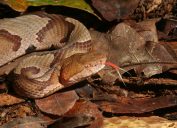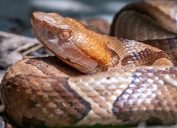Snake Expert Reveals How to Avoid "Extremely Painful" Copperhead Bites
You could be seeing more of these dangerous snakes right now.

Officials have been sounding the alarm on a potentially dangerous snake species after a string of sightings. Copperhead snake encounters have ratcheted up in multiple U.S. states. One woman in New Jersey was recently struck in both feet by this species, calling it the "worst pain you can imagine." In order to prevent more people from experiencing a similarly unpleasant fate, one snake expert is speaking out with vital advice. Read on to discover how to avoid "extremely painful" copperhead bites.
RELATED: A Copperhead Snake Bit a 4-Year-Old Boy—Here's Where It Was Hiding.
You may be more likely to come across copperheads right now.

Copperheads are multiplying across the country right now. That's because baby copperheads are born live (not from eggs), and births can happen anytime between mid-August and early October, Jeff Beane, Herpetology Collection Manager at the North Carolina Museum of Natural Science in Raleigh, told The News & Observer.
"Weather, geography, region and other factors can influence the exact time of birth," Beane said. "But usually the last few days of August and the first few of September are peak for copperheads."
At the same time, Hurricane Idalia could have displaced snakes like copperheads and pushed them into your homes, The State reported. They might seek shelter and food inside your space after major storms, as "damaged structures are more accessible to snakes and flooding may allow some snakes to swim or deposit them indoors," per NC Cooperative Extension.
RELATED: 8 Things in Your Yard That Are Attracting Snakes to Your Home.
Both baby and adult copperheads can be dangerous.

Baby copperheads have the same skin pattern as adult copperheads, but will be smaller and also have a bright yellow tip to their tail. This is a "big giveaway," Bill Crisp, a local reptile conservationist and educator with nonprofit K2C Wildlife Encounters, told Prince William Times.
"It is a very bright yellow, almost neon tail," he shared.
But don't breathe a sigh of relief if you run into a baby copperhead instead of an adult one. Copperheads "are dangerous from their first breath," Crisp warned, nothing that they are still venomous despite being tinier.
Younger copperheads are also less likely to control or withhold the amount of venom they inject, Beane told The News & Observer. However, they don't have as much venom as a mature snake.
RELATED: 17-Year-Old Bitten by Rattlesnake in His Home—Where It Was Hiding.
Experts say you can avoid copperhead bites.

There are certain behaviors you'll want to avoid. Most people end up getting bitten by a copperhead when they're taking their trash out in the dark while barefoot or wearing flip-flops, Crisp told Prince William Times.
Another common way people get bitten is by weeding or clearing leaves using their bare hands, he added.
In order to prevent snakes from making their way to your home in the first place, Crisp said homeowners should "get rid of clutter and keep grass and landscaping trimmed short." This encourages snakes to move on because you are not providing a habitat.
"Less overgrowth will limit the number of snakes in your yard because there is no place for them to hide and no food source. They won't want to stay," Crisp explained.
RELATED: For more up-to-date information, sign up for our daily newsletter.
Copperhead bites are "extremely painful."

If you come across a copperhead of any size in your home or yard, Crisp said you should never try to handle it on your own. Instead, call for help, he advised. And don't try to kill it either, Beane noted.
"Many bites and other injuries have occurred while people were attempting to kill snakes," he told The News & Observer. "No one was ever bitten by a snake while they were leaving it alone."
Copperhead snake bites are not usually fatal, but they are "extremely painful," according to Crisp. "Symptoms include swelling, redness in the area, nausea and vomiting and require a trip to the hospital," he said.
They commonly strike south of the ankle or on the hand, Crisp told Prince William Times. "Look for two puncture holes about half to one inch apart," he said.
If you think you have been bitten by a copperhead snake, the Centers for Disease Control and Prevention (CDC) recommends that you seek medical attention as soon as possible.





















